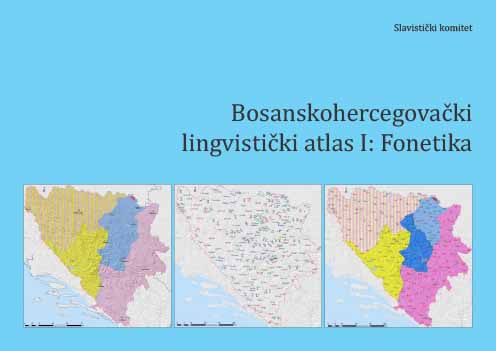Bosanskohercegovački lingvistički atlas I: Fonetika
Bosnian Linguistic Atlas I: Phonetics
Author(s): Senahid Halilović, Mehmed Kardaš, Amela Ljevo-Ovčina, Emira Mešanović-Meša
Subject(s): Phonetics / Phonology, Morphology, Lexis, South Slavic Languages
Published by: Slavistički komitet BiH
Keywords: linguistic atlas; Bosnian language; Croatian language; Serbian language; phonetics; morphology; etymology; lexis; dialects; štokavian; ijekavian; ikavian;
Summary/Abstract: Speech within the borders of Bosnia and Herzegovina falls within four sub-dialects of the štokavian dialect: Eastern Bosnian, Eastern Herzegovinian, Posavinian (or Slavonian) and Western.Two of them are non-novoštokavian (Eastern Bosnian and Posavinian) and two are novoštokavian (Eastern Herzegovinian and Western). Eastern Bosnian is ijekavian šćakavian, Eastern Herzegovinian is ijekavian štakavian, Posavinian is ikavian-jekavian štakavian, and Western isikavian štakavian-šćakavian. Two novoštokavian sub-dialects cover approximately two thirds of the territory of Bosnia and Herzegovina, and two non-novoštokavian cover one third, with the Posavinian sub-dialect covering the smallest territory: only seven villages in the Orašje municipalitys peak in this dialect. Eastern Bosnian and Western sub-dialects are spoken by Bosniaks and Croats, Serbs to a lesser extent; Eastern Herzegovinian is spoken by Bosniaks, Croats and Serbs; Posavinian is spoken by Croats only. Traces of the old division of the štokavian dialect into eastern and western variants is still evident in the speech varieties in contemporary Bosnia and Herzegovina: some reflect features of western štokavian origin, and some of the eastern štokavian. Frequent migrations and mixing of the population of different dialects contributed to the diversity of speech across the country. Moreover, with a pronounced religious and ethnic blending of the population, the dialects in Bosnia and Herzegovina are quite interesting.Scholarly literature on dialectology presents basic information about speech in Bosnia and Herzegovina.However, neither major monographs nor various contributions in the field of dialectology produced from the end of the 19th century onwards offer a view of linguistic phenomena in speech in Bosnia and Herzegovina as a whole – only linguistic atlases provide the geographic spread of certain phenomena in the given language coverage. Systemic linguo-geographic study of BiH speech has been made possible thanks to the material obtained through uniform questionnaires developed as part of the project entitled “BiH Dialectological Complex – Synchronous Description and Position of the Contemporary Standard Language” by the Language Institute in Sarajevo. The BiH Language Atlas (BLA) is based primarily on this corpus, collected throughout 1970s and 1980s. Field research continued in 2016 and 2017 with amendments to some of the questionnaires and the collelction was expanded by recordings from four previously unexplored speech varieties; BLA thus covers 230 local speech varieties. Speech by Bosniaks was researched in one hundred locations, speech by Serbs in eighty, and speech by Croats in fifty. Although speech has been changed considerably, due to movement and relocation of the population during the war in the early 1990s, materials collected between 1975 and 1986 and those from 2016 and 2017 are comparable and create a whole that allows for the production of a national linguistic atlas.The phonetic volume of BLA is the first in a series of volumes planned to be published, and itis the fruit of labour of more than thirty collaborators of the Slavic Committee. The introductory part presents key information about the project itself, a list of speech varieties examined,a list of orthographic markings of speech varieties covered, a list of field researchers with the number of questionnaires completed, a phonetic transcription system, a register of lexemes and a map of dialects and sub-dialects in Bosnia and Herzegovina. The main part is dedicated to themost important phonetic phenomena: of a total of 181 questions, 63 relate to vocalism and 118to consonantism. It contains transcribed recordings of speech varieties examined, a linguistic interpretation of the material, commentaries regarding the ethymology of the lexemes and maps with symbols representing the corpus, allowing th tracking of isophones, determination of areal features of certain phenomena, specification of dialect boudnaries and an overview of horizontal spread of BiH dialects. Each map includes a legend and data on the presence of specific forms with graphic representation. The lettering is in three colours (green: examined speech by Bosniaks;blue: speech by Croats; red: speech by Serbs) in order for the maps to reflect at the same time the differences based on the informants’ ethnic background. The annex present a word index,a list of cited bibliography, as well as a list of abbreviations, markings and graphic symbols.
- Print-ISBN-13: 978-9958-648-28-1
- Page Count: 428
- Publication Year: 2020
- Language: Bosnian
- eBook-PDF
- Table of Content

